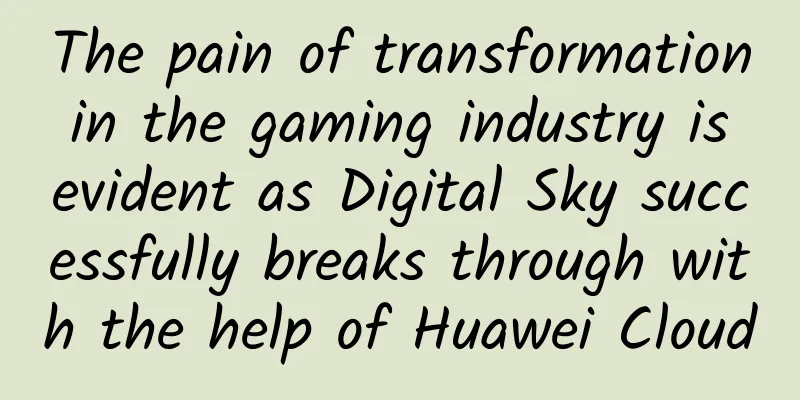The pain of transformation in the gaming industry is evident as Digital Sky successfully breaks through with the help of Huawei Cloud

|
[51CTO.com original article] In 2017, the total revenue of Chinese games reached 218.9 billion. The "2017 China Game Industry R&D Competitiveness Report" shows that the production capacity of China's game industry continues to rise, with more than 20,000 games developed annually. In the first three quarters, the revenue generated by self-developed products accounted for more than 95% of the market in the same period. However, behind the impressive data, there are several sets of data worth pondering: the number of R&D products of Chinese game companies from January to June 2017 has dropped significantly compared with the same period last year; the number of active R&D companies in China during the same period has also shown a downward trend compared with the same period last year; the number of companies that enter the iOS best-selling list in a single quarter is also declining. Only about 500 companies can enter the top 200 of the iOS daily best-selling list each year, accounting for less than 10%. Image from the 2017 China Game Industry R&D Competitiveness Report People with a keen sense of smell have already sensed a hint of crisis. China's mobile games are going through a bubble period of "rushing in", the initial demographic dividend is disappearing, and the industry is becoming more mature. This of course also means that in the fierce competition that follows, only those game companies with strong operational capabilities, high innovation capabilities, and the ability to quickly develop and adapt to the market will have the best laugh, while companies with poor R&D capabilities are likely to be forced to exit early. Chengdu Digital Sky Technology Co., Ltd. ("Digital Sky" for short) is one of the companies that first sensed the crisis. It's hard to dance with shackles The reason why it is so surprising is that this Internet company, which was founded in 2011 and focuses on the development and distribution of mobile game products, has actually achieved remarkable results in the game industry and has a good reputation overseas. Let's take a look at the company's development history: In 2012, Digital Sky was selected as the top mobile game developer in China by British media PocketGamer; In 2014, it was selected by foreign media as one of the top 30 mobile game developers in China; the company's products "Dragon Power" and "Heroes of the World" were once the top 5 products in Google Play/App Store in the Asia-Pacific region; In 2015, Dragon Ball Fighter launched by Digital Sky quickly ranked in the top 3 of the App Store bestseller list after its launch, and its turnover exceeded 100 million for several consecutive months, becoming an S-level product; Blue Dragon Three Kingdoms was the recommended game of 2015 by Google Play in Korea; In 2016, Digital Sky launched its first game, Girls Frontline, and officially entered a period of diversified development... How could such a popular gaming company have such a strong sense of crisis? This must first start with Digital Sky’s game development model. In the past, Digital Sky adopted the traditional waterfall R&D model. The R&D idea of this model is to plan all the problems first, plan all the details, and then design, and then develop and deliver. From the process point of view, the entire R&D process is step-by-step, and development, testing, and delivery are presented in a serial state. For games, this is actually not suitable. As we all know, game demand is changeable and needs to be adjusted in time according to market hot spots and feedback. Taking the cycle of launching a game every 6 months as an example, using the waterfall R&D model, many designs and plans six months ago can no longer meet the market demand six months later. Under this traditional model, the drawbacks become increasingly obvious: First, R&D is slow and inefficient. The workload of demand development is evaluated on a day or week basis. A development team of more than 10 people can only deliver about 20 requirements per week on average. Secondly, the company built its own compilation environment, which was slow to build. There were dedicated people responsible for package delivery, which was inefficient; Another problem is the lack of automation capabilities, as all 10 steps of continuous integration require manual operation. ***The internal management costs and cross-team collaboration costs are high, and there is a lack of end-to-end platform support. Digital Sky quickly realized these problems and began to actively seek change. Transformation is easier said than done However, it is easier said than done, and it is difficult to change the working mode that forms a fixed mindset. Although Digital Sky actively explored the path of transformation, the progress was not satisfactory at the beginning of the transformation. The first hurdle is the change of perspective. People don’t have a clear understanding of transformation. What is agile development? What is lean R&D? There are a thousand Hamlets for a thousand people. The second hurdle is lack of practice. How to quickly implement business and how to quickly iterate game development? Digital Sky has no practical experience in this area. The third barrier is the lack of an efficient R&D platform. After realizing that the waterfall R&D model was becoming a dead end, Digital Sky’s R&D team began to try to use various open source software, starting with development and project management. However, these open source tools were independent of each other, like chimneys. For example, code storage was on one server, and document data was on another server. The data calls during the entire R&D process were not performed on an equal end-to-end platform. The fourth hurdle is communication difficulties, because without an equal end-to-end platform, all communication is not smooth. It was not until August 2017 that Digital Sky encountered Huawei Cloud and the above bottleneck was resolved. Meet Huawei Cloud and start a different transformation journey The cooperation between the two parties started with the transformation of the R&D team. The Huawei Cloud expert team moved into Digital Sky and selected a R&D team of more than ten people as a pilot. While investigating application scenarios, the Huawei Cloud expert team passed on the software development cloud's 30 years of experience to them, using technology to improve efficiency. The traditional waterfall development model is replaced by the Huawei Cloud agile development model. The same 6-month game delivery plan is used, but agile development further refines the development work. For example, planning, development, and testing start in the first week of the first month, and then the second and third weeks continue to cycle through the various links. It is not important to plan and conceive at the beginning, but only do the most valuable things and make adjustments while doing them. This "small steps and fast running" has a finer granularity, can avoid waste, and improve efficiency. There is no longer a situation where 80% of the work is developed but the whole thing is abandoned. When Huawei Cloud technical experts first arrived at Digital Sky, a small story happened. When the expert communicated with each role in the team, he found that everyone had different understandings of the same thing. For example, when the game product manager talked about product conception and design, even if they communicated face to face, everyone had different understandings and discussion standards, and there was a deviation in consensus. The artists, programmers, and planners were all sketching their own pictures. Later, the expert recommended the mind map function in Huawei Cloud Game Development Solution to them. Everyone can use the mind map to draw a portrait of the product and clearly plan the effect, which solves the problem of communication ambiguity.
Huawei Cloud experts explain game development solutions to the Digital Sky development team Two weeks later, the development efficiency of the pilot team impressed the entire company and was subsequently promoted throughout the company. After two months of running-in, Digital Sky smoothly transitioned to the agile R&D model, with obvious changes: the overall product delivery efficiency increased by 25%; the demand development workload was evaluated on an hourly basis; an average of 60+ requirements were delivered each week, and the R&D throughput increased by 50%; cloud-based parallel compilation was achieved, with compilation and build speeds reduced from hours to minutes, especially on the C++ server side; 8 of the 10 R&D continuous integration links were automated, increasing continuous integration efficiency by 80%; and a one-stop DevOps R&D system and process that spans game development, testing, and operations was built. In the future, Huawei Cloud game development solutions will continue to evolve. From a technical perspective, it will realize a one-stop container deployment platform. From a user perspective, it will implement the game company's boutique strategy, plan game automation testing experiments, and provide game stress testing services. From the perspective of ecosystem construction, it will focus on the future, integrate blockchain and AI technologies, and form a research and development ecosystem with complementary advantages with partners. Looking back now, the benefits that Huawei Cloud has brought to Digital Sky in terms of agile iteration, compilation and construction are obvious. Because the establishment of an end-to-end one-stop DevOps R&D system and process cannot be achieved without a lot of manpower, technical strength, money and time. With its more than 30 years of experience in software development, Huawei Cloud has built such a full-life cycle one-stop platform for game companies, which runs through all links such as game development, testing, and operation and maintenance, helping companies to achieve seamless connection with a very high cost-effectiveness. Not only that, Huawei Cloud's game development solution can also be connected with all other business lines of Huawei Cloud to call on more basic technical capabilities. Such an open and flexible solution not only helps game companies save a lot of manpower and time costs, allowing game companies to invest more energy in innovation, but also turns creativity into income, quickly realizes in game development, and has stronger competitive strength. [51CTO original article, please indicate the original author and source as 51CTO.com when reprinting on partner sites] |
<<: The first call was made to speed up 5G commercial use
>>: The architecture needs to be upgraded urgently as operators lay out their future networks
Recommend
As 5G technology matures, can it help accelerate the implementation of blockchain?
2019 has become the hot spot for the development ...
Wi-Fi 6 testing completes, global deployment to begin in 2021
The Wireless Broadband Alliance (WBA) has announc...
[Black Friday] GreenCloudVPS: Multi-room 3G memory KVM only $28/year, 1TB large plate chicken starts at $52 for two years
GreenCloudVPS's Black Friday event has begun....
Why restarting the router frequently makes WiFi faster
Using WiFi to surf the Internet has become an ind...
GitHub requires two-factor authentication for all accounts!
GitHub has announced that before 2023, all develo...
Digital twins, the Internet of Things, and new technologies that can help remote work
In recent years, the traditional offline working ...
SA: Global 5G users exceed 1 billion, and 5G networks will cover 36% of the world's population
Strategy Analytics released a report today saying...
Ruijie appeared at GITC: Internet companies please give me a thumbs up!
[[177701]] [51CTO.com original article] The GITC ...
Server-Speaks-First is a bit of a bummer, protocol detection and opaque ports in Linkerd 2.10
[[416375]] This article is reprinted from the WeC...
Analysis of API Gateway Selection of Several Major Cloud Vendors
1. What is an API Gateway? An API Gateway is a wa...
Can 6G technology directly skip 5G technology?
1G→5G: There is precedent for skipping As far as ...
Wi-Fi signals are invisible and intangible, but there are actually traces to follow
Labs Guide Have you ever encountered the phenomen...
The Industrial Internet of Things is coming in full force. Wind River shows you how to keep the industrial control system “on track”
[51CTO.com original article] "Stable and rel...
4G is still growing, and 5G is still a long way off
Recently, the Ministry of Industry and Informatio...
IPv6 basics, learn in one minute
1. Introduction to IPv6 1. IPv6 was previously kn...









